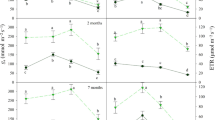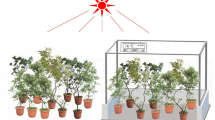Abstract
In order to quantify the effects of thinning on biochemical photosynthesis parameters and changes in leaf nitrogen contents associated with the process of crown reclosure, the maximum rate of carboxylation (V cmax), the leaf nitrogen concentration per unit area (N a), and the photosynthetic photon flux density (PPFD) were measured at four crown heights in both thinned (1500 trees ha−1) and unthinned control (3000 trees ha−1) stands of ten-year-old Chamaecyparis obtusa (36°3′N, 140°7′E) trees during four consecutive growing seasons after thinning. Thinning increased V cmax in the lower and middle crowns in the first year after thinning, and leaves in the lower crown of the thinned stand maintained high V cmax for four years, whereas they abscised in the second year in the control stand. Significant increases in V cmax were detected even in the upper crowns of trees in the thinned stand in the second year. Thinning did not affect N a at any of the crown positions in the first year, but significantly increased N a in the middle crowns from the second year after thinning. Thus, the redistribution of nitrogen between leaves, driven by increases in light and nutrient availability due to the 50% thinning, appears to have enhanced photosynthetic rates in the thinned stand. Thinning also significantly affected the slope of the linear relationship between N a and V cmax initially after thinning, but its effect on this relationship was negligible after the second year. These quantitative results may be used to simplify the estimation of the likely effects of management practices on carbon fixation in forest canopies.







Similar content being viewed by others
References
Bernacchi CJ, Singsaas EL, Pimentel C, Portis ARJ, Long SP (2001) Improved temperature response functions for models of Rubisco-limited photosynthesis. Plant Cell Environ 24:253–259
Blanco JA, Imbert JB, Castillo FJ (2008) Nutrient return via litterfall in two contrasting Pinus sylvestris forests in the Pyrenees under different thinning intensities. For Ecol Manag 256:1840–1852
Bréda N, Granier A, Aussenac G (1995) Effects of thinning on soil and tree water relations, transpiration and growth in an oak forest (Quercus petraea (Matt.) Liebl.). Tree Physiol 15:295–306
Brooks JR, Sprugel DG, Hinckley TM (1996) The effects of light acclimation during and after foliage expansion on photosynthesis of Abies amabilis foliage within the canopy. Oecologia 107:21–32
Evans JR (1989) Photosynthesis and nitrogen relationships in leaves of C3 plants. Oecologia 78:9–19
Farquhar GD, von Caemmerer S, Berry JA (1980) A biochemical model of photosynthetic CO2 assimilation in leaves of C3 species. Planta 149:78–90
Ginn SE, Seiler JR, Cazell BH, Kreh RE (1991) Physiological and growth responses of eight-year-old loblolly pine stands to thinning. For Sci 37:1030–1040
Gravatt DA, Chambers JL, Barnett JP (1997) Temporal and spatial patterns of net photosynthesis in 12-year-old loblolly pine five growing seasons after thinning. For Ecol Manag 97:73–83
Han Q, Kawasaki T, Katahata S, Mukai Y, Chiba Y (2003) Horizontal and vertical variations in photosynthetic capacity in a Pinus densiflora crown in relation to leaf nitrogen allocation and acclimation to irradiance. Tree Physiol 23:851–857
Han Q, Kawasaki T, Nakano T, Chiba Y (2004) Spatial and seasonal variability of temperature responses of biochemical photosynthesis parameters and leaf nitrogen content within a Pinus densiflora crown. Tree Physiol 24:737–744
Han Q, Araki M, Chiba Y (2006) Acclimation to irradiance of leaf photosynthesis and associated nitrogen reallocation in photosynthetic apparatus in the year following thinning of a young stand of Chamaecyparis obtusa. Photosynthetica 44:523–529
Hikosaka K (2005) Leaf canopy as a dynamic system: ecophysiology and optimality in leaf turnover. Ann Bot 95:521–533
Jiménez E, Vega JA, Pérez-Gorostiaga P, Cuiñas P, Fonturbel T, Fernández C, Madrigal J, Hernando C, Guijarro M (2008) Effects of pre-commercial thinning on transpiration in young post-fire maritime pine stands. Forestry 81:543–557
Johnsen K, Samuelson L, Teskey R, McNulty S, Fox T (2000) Process models as tools in forestry research and management. For Sci 47:2–8
Kolb TE, Holmberg KM, Wagner MR, Stone JE (1998) Regulation of ponderosa pine foliar physiology and insect resistance mechanisms by basal area treatments. Tree Physiol 18:375–381
Landsberg JJ, Waring RH (1997) A generalised model of forest productivity using simplified concepts of radiation-use efficiency, carbon balance and partitioning. For Ecol Manag 95:209–228
Lavigne MB (1988) Growth and net assimilation rates in thinned and unthinned stands of balsam fir. Can J For Res 18:1205–1210
Medhurst JL, Beadle CL (2001) Crown structure and leaf area index development in thinned and unthinned Eucalyptus nitens plantations. Tree Physiol 21:989–999
Medhurst JL, Beadle CL (2005) Photosynthetic capacity and foliar nitrogen distribution in Eucalyptus nitens is altered by high-intensity thinning. Tree Physiol 25:981–991
Medlyn BE, Dreyer E, Ellsworth D, Forstreuter M, Harley PC, Kirschbaum MUF, Le Roux X, Montpied P, Strassemeyer J, Walcroft A, Wang K, Loustau D (2002) Temperature response of parameters of a biochemically based model of photosynthesis. II. A review of experimental data. Plant Cell Environ 25:1167–1179
Meir P, Kruijt B, Broadmeadow M, Barbosa E, Kull O, Carswell F, Nobre A, Jarvis PG (2002) Acclimation of photosynthetic capacity to irradiance in tree canopies in relation to leaf nitrogen concentration and leaf mass per unit area. Plant Cell Environ 25:343–357
Morikawa Y, Hattori S, Kiyono Y (1986) Transpiration of a 31-year-old Chamaecyparis obtusa Endl. stand before and after thinning. Tree Physiol 2:105–114
Nagakura J, Kaneko S, Takahashi M, Tange T (2008) Nitrogen promotes water consumption in seedlings of Cryptomeria japonica but not in Chamaecyparis obtusa. For Ecol Manag 255:2533–2541
Peterson JA, Seiler JR, Nowak J, Ginn SE, Kreh RE (1997) Growth and physiological responses of young loblolly pine stands to thinning. For Sci 43:529–534
Sabaté S, Gracia CA, Sánchez A (2002) Likely effects of climate change on growth of Quercus ilex, Pinus halepensis, Pinus pinaster, Pinus sylvestris and Fagus sylvatica forests in the Mediterranean region. For Ecol Manag 162:23–37
Schoettle AW, Smith WK (1999) Interrelationships among light, photosynthesis and nitrogen in the crown of mature Pinus contorta ssp. latifolia. Tree Physiol 19:13–22
Simioni G, Ritson P, McGrath J, Kirschbaum MUF, Copeland B, Dumbrell I (2008) Predicting wood production and net ecosystem carbon exchange of Pinus radiata plantations in south-western Australia: application of a process-based model. For Ecol Manag 255:901–912
Skovsgaard JP (2009) Analysing effects of thinning on stand volume growth in relation to site conditions: a case study for even-aged Sitka spruce (Picea sitchensis (Bong.) Carr.). Forestry 82:88–104
Smith DM (1986) The practice of silviculture. Wiley, New York
Stupak I, Nordfjell T, Gundersen P (2008) Comparing biomass and nutrient removals of stems and fresh and predried whole trees in thinnings in two Norway spruce experiments. Can J For Res 38:2660–2673
Tang Z, Chambers JL, Guddanti S, Barnett JP (1999) Thinning, fertilization, and crown position interact to control physiological responses of loblolly pine. Tree Physiol 19:87–94
Tang Z, Chambers JL, Sword MA, Barnett JP (2003) Seasonal photosynthesis and water relations of juvenile loblolly pine relative to stand density and canopy position. Trees 17:424–430
Warren CR, Adams MA (2001) Distribution of N, Rubisco and photosynthesis in Pinus pinaster and acclimation to light. Plant Cell Environ 24:597–609
Wilson KB, Baldocchi DD, Hanson PJ (2000) Spatial and seasonal variability of photosynthetic parameters and their relationship to leaf nitrogen in a deciduous forest. Tree Physiol 20:565–578
Wullschleger SD (1993) Biochemical limitations to carbon assimilation in C3 plants—a retrospective analysis of the A/C i curves from 109 species. J Exp Bot 44:907–920
Yu S, Chambers JL, Tang Z, Barnett JP (2003) Crown characteristics of juvenile loblolly pine 6 years after application of thinning and fertilization. For Ecol Manag 180:345–352
Acknowledgments
This research was supported by a grant from the Japanese Ministry of the Environment for Global Environment Research.
Author information
Authors and Affiliations
Corresponding author
About this article
Cite this article
Han, Q., Chiba, Y. Leaf photosynthetic responses and related nitrogen changes associated with crown reclosure after thinning in a young Chamaecyparis obtusa stand. J For Res 14, 349–357 (2009). https://doi.org/10.1007/s10310-009-0146-4
Received:
Accepted:
Published:
Issue Date:
DOI: https://doi.org/10.1007/s10310-009-0146-4




